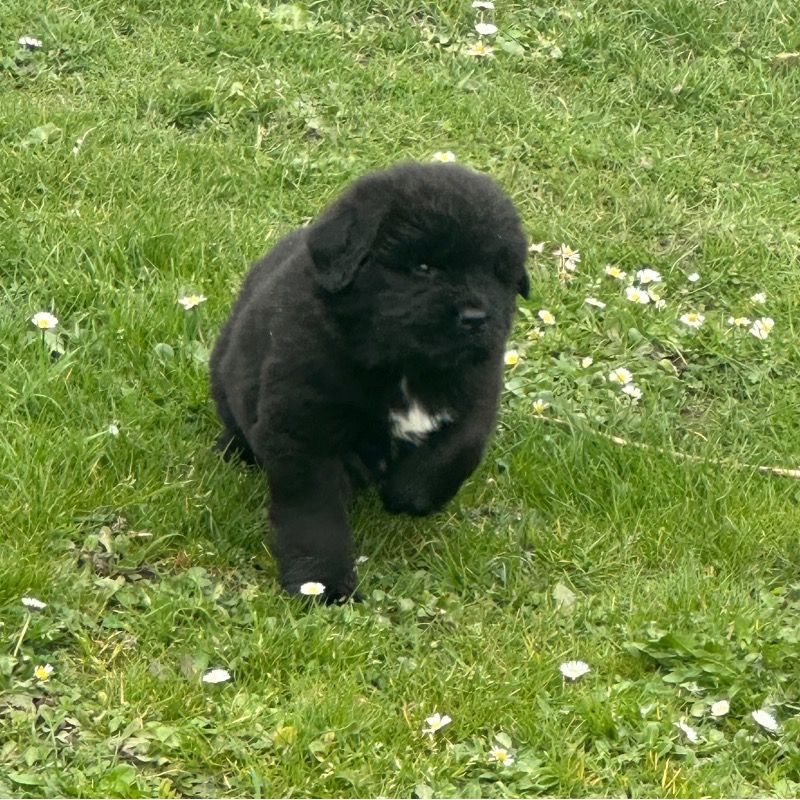Saint bernard
Welcome to our page dedicated to the breed of dog saint bernard!
Here, you will find all the useful information about saint bernard. This descriptive profile will allow you to discover the aspects of this breed. You can notably consult information about the average price, monthly and annual upkeep expenses, their health, name ideas, as well as their official recognition by competent authorities.
Explore this page to discover everything you need to know.
Overall description of the breed
The origins of the Saint Bernard trace back to extremely ancient times. This gentle-hearted giant has been present in Europe for centuries, likely as one of the numerous descendants of the Tibetan Mastiff, an Asian-origin molossus with ancestral roots. It primarily developed in the Alps, around the Great St. Bernard Pass in Switzerland, from which it inherited its name.
The ancestors of the Saint Bernard were gathered and developed by the canons, faithful men who welcomed those in need into their monastery. Present in this region since the 16th century, it was mainly employed as a guard dog. Its role in rescue operations emerged later, owing to its numerous physical qualities, keen sense of smell, and courage.
By the end of the 19th century, a Swiss breeder named Heinrich Schumacher was the first to establish rigorous selection criteria for the Saint Bernard, with well-defined morphological traits and documented genealogy. On March 15, 1884, the first breed club opened its doors in Basel. In 1887, the breed was recognized as Swiss in origin by most major worldwide canine organizations, an acknowledgment obtained during the cynological congress in Zurich. Over 50 years later, the International Cynological Federation officially registered it on August 28, 1954, and its currently effective standard was published on April 4, 2016.
The Saint Bernard is one of the largest dogs on the planet, a molossus type. Its imposing size and stature are remarkable, and it is particularly valued for mountain rescue operations due to its exceptional physical qualities. Slightly longer than tall, its body forms a rectangle. Despite its massive build and well-developed musculature, the Saint Bernard maintains surprising agility and graceful movements.
It possesses a voluminous and sturdy bone structure, with a broad and deep chest, ample and well-descended ribcage, rounded and arched ribs, and a round abdomen. Its backline is straight, compact, and robust. Its tail is heavy and thick, always carried horizontally and slightly curved upward at the tip. Its head is massive and imposing, proportionate to the rest of the body, with particularly expressive features. Its large skull is dome-shaped, accompanied by a moderately long muzzle and a well-defined stop. Its coat can be long or short, but it's always abundant, with a smooth and soft texture.
It's also endowed with a remarkably dense undercoat, offering excellent protection against cold and snow. The colors accepted by the standard are white with black, brown, or red markings.
The Saint Bernard is an affectionate and extremely devoted dog to its owners. Its protective instinct is highly developed, and it would be willing to give its life to save that of its loved ones. Cautious with strangers entering its territory, it will take some time for it to fully trust unfamiliar individuals. It's an intelligent dog that quickly comprehends expectations. Skilled in obedience, it seeks to please its family by participating in playful activities or anticipating dangerous situations.
Versatile and attentive to its environment, it is remarkably effective at work. Devoted and willing, the Saint Bernard delights in spending time with its masters. Its training is straightforward if begun from a young age. Firm and consistent authority will be necessary for it to find its place, as its exceptional size could pose issues if not handled appropriately.
Cheerful and very affectionate, especially with children, with whom it forms a close bond, the Saint Bernard possesses a balanced and confident temperament. It can remain alone for extended periods without developing anxiety or destructive behavior.
Loyal and faithful, the Saint Bernard is an ideal life companion for individuals who have time to dedicate to it or have ample space to fulfill its energy needs. Family life and interaction with its social group are essential to its well-being. Confident and comfortable, it will fulfill all your expectations and take care of all household members with kindness.
In adulthood, the Saint Bernard weighs between 50 and 90 kg (110 to 200 lb) and stands between 70 and 90 cm (27.5" - 35.5") at the withers for males, and between 65 and 80 cm (25.5" - 31.5") for females.
Awareness of acquiring an animal
Each animal is a sensitive being, deserving love, attention and care.
When you choose to adopt an animal, you take on the responsibility of ensuring its health and well-being throughout its life.
To learn more about animal welfare, we invite you to consult our FAQ by clicking the button below:
Origins
The Saint Bernard gets its name from the Great Saint Bernard Hospice, a refuge for travelers in the Swiss Alps, where these dogs were used by monks from the 17th century. They were bred for the search and rescue of lost or injured travelers in the snow and fog.
History
Saint Bernards have become famous for their incredible sense of direction and their ability to detect victims buried under the snow. The most famous dog of this breed, Barry, is said to have saved more than 40 people. Over time, they have transitioned from working dogs to family companions and participants in dog shows.
Standard
According to the standard, the Saint Bernard is a massive dog, with an imposing head, expressive eyes, and a broad mouth. It comes in two coat varieties: short-haired and long-haired, both requiring a dense undercoat. The coat color varies from red with white to white with red, often featuring black markings on the head.
Physical characteristics
With a powerful and muscular stature, Saint Bernards can reach a height of 70 to 90 cm at the withers and weigh up to 140 kg. Their imposing appearance is balanced by their gentle and friendly expression.
Character
The Saint Bernard is known for its calm, patient, and friendly temperament. These dogs are extremely loyal and affectionate with their family, often showing a special sensitivity towards children. They can be reserved with strangers, but are rarely aggressive.
Life expectancy
The life expectancy of the Saint Bernard generally varies between 8 and 10 years. Their large size can contribute to some health problems, but with proper care, they can lead a healthy and fulfilling life.
Exercise and activity needs
Despite their size, Saint Bernards do not have excessive exercise needs. Daily walks and space to stretch their legs are sufficient. They enjoy gentle play and are particularly happy in snowy environments.
Recommended diet
A balanced diet, rich in nutrients and adapted to their large size, is essential for maintaining their health. It is important to monitor their weight to avoid obesity and joint problems.
Training and obedience
Although naturally gentle, the Saint Bernard benefits from firm and consistent training. Their adult size requires early learning of good manners, especially walking on a leash without pulling.
Behavior with children
The Saint Bernard is exceptionally patient and gentle with children, making him an excellent family dog. However, their large size requires supervision to avoid accidental injuries.
Compatibility with Other Animals
Generally, Saint Bernards get along well with other pets, especially if they are raised together. Their peaceful nature makes integration into a multi-animal household easier.
Grooming needs
Grooming varies according to the type of coat. Long-haired varieties require regular brushing to prevent knots and reduce hair loss, while short-haired ones require less maintenance.
Health
The Saint Bernard can be prone to health issues such as hip dysplasia, heart diseases, and bloating. Regular veterinary check-ups and special attention to their diet and exercise are important.
Average price
The cost of a Saint Bernard puppy can range between 1000 and 2000 euros, depending on the lineage, the breeder's reputation, and the adherence to the breed standard.
Expenses
The annual costs for a Saint Bernard, including food, veterinary care, and grooming, can amount to about 1500-3000 euros, due to their large size.
Name ideas
Names like Bernard, Barry, Goliath, Bella, and Daisy are popular for Saint Bernards, often reflecting their imposing stature or heroic heritage.
Legislation and regulation
There is no specific legislation regarding Saint Bernards. As with all breeds, it is important to ensure they have adequate space and receive proper training.
Official recognition
The Saint Bernard is recognized by the main canine organizations, including the SKG (Schweizerische Kynologische Gesellschaft) in Switzerland, the VDH (Verband für das Deutsche Hundewesen) in Germany, the KC (The Kennel Club) in the United Kingdom, the LOF (Livres des Origines Françaises) in France, and the CKC (Canada Kennel Club) in Canada, all of which are affiliated with the Fédération Cynologique Internationale (FCI).
Pedigrees
Pedigrees, certifying the purity of the Saint Bernard's lineage, are available from breed clubs and cynological organizations.
Destination and usage
Historically used for mountain rescue, Saint Bernards are now primarily family companions, cherished for their loving and protective nature.
Prohibitions
There are no specific prohibitions for the Saint Bernard. However, special attention must be paid to their health and well-being due to their large size.
Breeders of Saint bernard
Want to see more breeders of Saint bernard?
Check out the page of our directory listing all breeders of Saint bernardClassified Ads of saint bernard
No of saint bernard classified ads are available on Preeders.
If you’re a breeder, sign up for free now and be the first to post a classified ad
Breed clubs of saint bernard
No of saint bernard breed clubs are currently registered on Preeders.
If you would like to highlight your breed club, sign up for free now and be the first to appear on this page.




